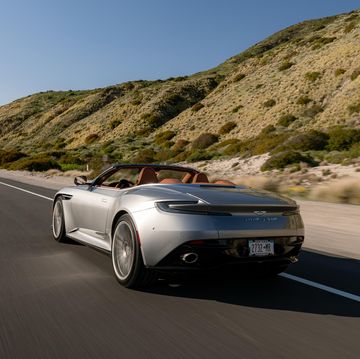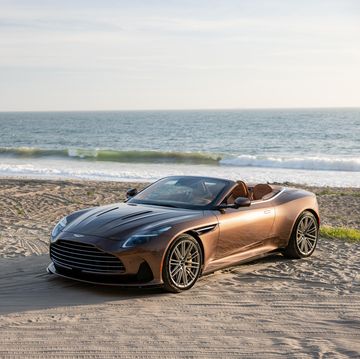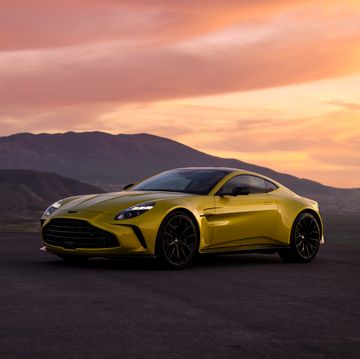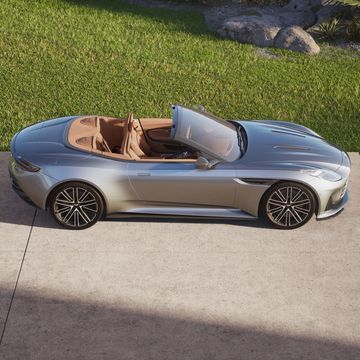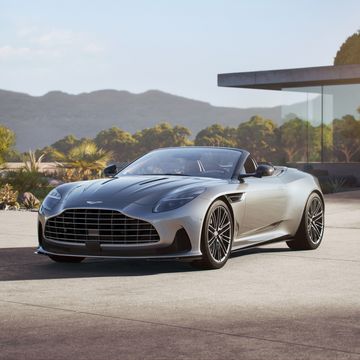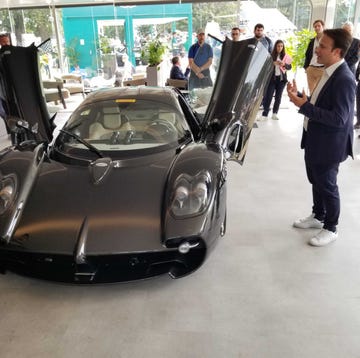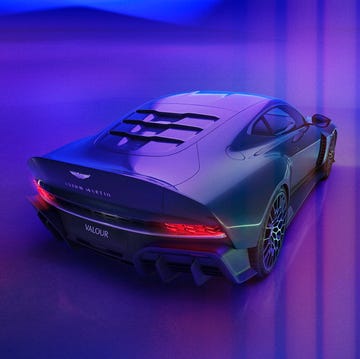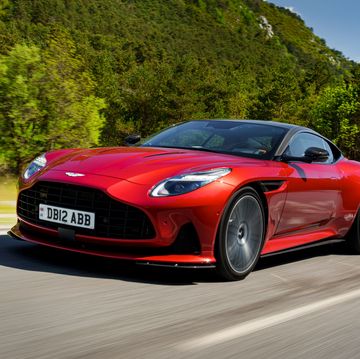- The 2025 Vantage is the most track-ready car in the Aston Martin portfolio short of a Valkyrie or a Valhalla.
- It's a little unstable at the limit, and the brakes failed on some cars that were on the track with us, but man was it fun.
- Starting price is a mere $194,400, available in Q2.
When you think of Aston Martin, you might think of fast, luxurious, grand touring conveyances like the recently new DB12. When duty calls and you have to cross the country—or the continent—at maximum velocity but you want to arrive fresh, relaxed, and ready for action when you get there, you want a DB12. For that, Aston puts the “Grand” in Grand Touring.
But when you have something more immediate, something like escaping Interpol, outgunning your rival on the Passe du Whatevs, or a day on a really great race track, you want a Vantage.
The Vantage shares a few things with the larger, more luxurious DB12, like its 656-hp twin-turbo V8, but it gets a shorter final drive after the ZF eight-speed transmission for quicker response. It also rides on a shorter wheelbase than the DB12 for greater agility.
Aston calls it an “ultra-luxury, performance sports car,” a term that from any other manufacturer might be dismissed as hyperbole, heavy on the hype. But after a day at the muy rapido Circuito Monteblanco in sunny Spain, we have to agree.
The Vantage name was originally applied to Aston Martin models that had more power and performance than their more luxurious, more streetable siblings. It first appeared as a variant of the DB5 in 1964. The first standalone Vantage appeared in the early 1970s and from thence Vantage has shone as its own, highly fun, performance model.
In international GT racing, it is the Vantage that Aston chose to enter in races all over the world. The Vantage competes in the FIA World Endurance Championship and British GT Championship, and it’s aiming for its 20th class win at Le Mans this year, among other races. It’s ready for it.
The AMG-sourced 4.0-liter twin-turbo V8 in the road-going Vantage has been heavily reworked by Aston Martin with modified cam profiles, an optimized compression ratio, larger turbos and increased cooling. The peak power and torque of 656 hp and 590 lb-ft - good for a claimed 0-60 time of 3.4 seconds - is a significant leap over the previous Vantage, which was “only” 503 hp and 505 lb-ft. Some changes had to be made to accommodate the increase.
“It required a lot more cooling,” said Simon Newton, director of vehicle performance, whose career includes stints at Lotus, Bentley, and even Williams F1. “All this power and torque required a lot more cooling. We have clearly a much bigger grille so there’s a lot more flow going in, 29% more airflow to the coolers. We’ve actually had to double-stack some of the coolers, so there’s 51% more airflow in the new arrangement. The net result of this is the car has the ability to operate in hot ambience on track 10 degrees greater than the old car, which is quite significant.”
It rides on new Bilstein dampers shared with the DB12 that Simon said are “very good at balancing primary and secondary ride. So you can have the sensation that you know exactly what’s happening at the tire contact patch. You feel what's going on down a broken road, but it’s in no way disturbing the body and roll for example. The system is quite good at separating, as I say, primary and secondary content, keeping the body nice and flat.”
The Vantage rolls on bespoke Michelin Pilot Sport S 5 tires, 275/35 ZR 21 in front and 325/30 ZR 21s rear.
“They are a good combination of wet and dry performance,” said Simon. “They’re also a good combination of lateral capacity and steering connection. Sometimes when you have a very grippy tire, you don’t always have the on-centered connection. We worked with Michelin trying to build the best of both worlds.”
The shortened chassis is likewise distinct from the DB12 in terms of springs, bars, and dampers.
“We tune it very much to give you this on-centered connection and exploitable handling characteristics.”
As a result, the lateral capacity has gone up significantly and understeer has been reduced.
“So it’s a much more agile proposition.”
Complementing the base handling characteristics are advanced chassis controls in the form of a Bosch Integrated Vehicle Controller. Aston Martin introduced this one on the DB12—it’s what Simon called a feed forward system for lateral dynamics, traction, and brakes.
“It gives you a clear picture what the car is doing. It can predict when an interaction is required from the system, and it comes in very early, very lightly, not at all disruptive to the driving experience.”
You can choose from several different stability control driving modes, and from there you can dial back as much traction control as you like—all the way to “off.”
“It’s a powerful system and great fun as a driving aid, as well as with tractive benefits.”
To try it out, we were sent onto the Circuito Monteblanco outside Seville, Spain, and had at it.
iQue barbaro!
We started out in a lead-follow exercise to get everyone used to the track and the car, and on the very first lap—the very first—someone spun out. This is rare, but no one hit him and all was well.
Then, after a few more laps—the fools!—they let us all go without adult supervision. There wasn’t even an admonishment to come in after three laps as there usually is in these situations. Everyone just stayed out and did maybe ten laps a session, or about that by the end of the day.
“This is great,” my brain said inside my borrowed helmet, using the same words Flounder used at the end of Animal House.
I started out in Sport mode and dialed the traction control up. I could feel the intervention politely keeping me from spinning out. Others on the track—bolder, younger, with better insurance—switched TC off and were spinning everywhere. Some British-sounding voice came on the radio and said, “There seem to be a lot of spins so the course marshals have asked everyone to please be more careful.”
Ha!
I set traction control to 5 on a scale of one to nine and, before I realized what had happened, I, too, spun, which I don’t think I ever do, powering out of a corner. I am a cagey veteran, a practiced track participant—I never spin.
Yet there I was, going backwards, eyeing the Armco that ran parallel to my now-reverse course, looking for the next Aston Martin Vantage to come around the corner at me. When the car spins, it goes into neutral, which took me a second to realize, then it took another second to put it in reverse and back down the rest of the runoff area. Timing it for what I hoped would be an empty spot in the field, I whipped back onto the track and kept right on going!
I haven’t had this much fun on a race track in I don’t know how long. The Vantage has perfect 50/50 balance, meaning anything that happens is largely your own fault. You can go faster and more precisely in a McLaren—I’m thinking of when I drove the Senna at Estoril.
A Ferrari 296 that I drove at this very track a year or two ago was almost as precise as the McLaren 720S, 750S, or the Senna but less brutal than any of those. The Lamborghini Huracan STO is a little less precise than its competitors but looks good. The Maserati MC20 is more comfortable but still closer to a race car.
This Vantage was like all those cars but far more comfortable. As you’re spinning around going backwards and looking like you’re out of control it’s saying, “Spot of tea, govnor?”
Other drivers complained of brake fade, some used the term “brake failure.” It only lasted a couple corners, but that could be an issue if you did this regularly. I braked between the 2 and the 3 at the end of Monteblanco’s 165-mph front straight. If you were really going to track these you’d set up the brakes for multiple hot laps, with appropriate track pads and racing brake fluid. Ours were set for street duty.
We also drove these cars on the public roads around Monteblanco and found them to be powerful performers there, too. The most impressive and useful aspect of the cars on the street was the way they power out of turns, those 590 lb-ft at the ready way down low in the rev band and swatting you out of the apex like a “door supervisor” throws you out of a pub at closing time in the East End.
The question comes down to what you want your supercar to do. If you demand absolute, on-the-edge-performance, you can get the McLaren 750S. If you want something you can drive all year in any different situation and have a blast doing it, consider an Aston Martin Vantage. The closest competitor might be the Porsche 911 GTS, but you now have a choice when looking for a daily driver that can also be fun on a race track.
Mine (mine for a few hours) stickered for $261,900, but that’s because it was loaded with things like a $10,000 Bowers and Wilkens audio system and $14,400 carbon-ceramic brakes (which are, apparently, not worth it). The base price is a mere $194,400, but no one buys a base model—get the contrast stitching, for goodness sake. Global deliveries begin in Q2.
And don’t be afraid of spinning out—just time your aggressive throttle application for a spot with some runoff. Or leave the traction and stability controls on.
Would you choose an Aston Martin Vantage, or a more aggressive track toy? Please comment below.

Mark Vaughn grew up in a Ford family and spent many hours holding a trouble light over a straight-six miraculously fed by a single-barrel carburetor while his father cursed the Blue Oval, all its products and everyone who ever worked there. This was his introduction to objective automotive criticism. He started writing for City News Service in Los Angeles, then moved to Europe and became editor of a car magazine called, creatively, Auto. He decided Auto should cover Formula 1, sports prototypes and touring cars—no one stopped him! From there he interviewed with Autoweek at the 1989 Frankfurt motor show and has been with us ever since.





